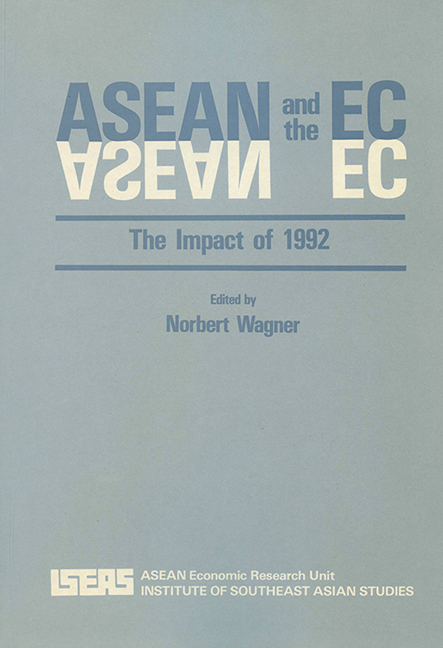Book contents
- Frontmatter
- Contents
- List of Tables
- List of Figures
- Acknowledgements
- PART I INTRODUCTION
- PART II COMPLETING THE EC INTERNAL MARKET
- PART III IMPLICATIONS FOR ASEAN
- V An Analysis of ASEAN-EC Trade in Textiles and Electronics, 1980–88
- VI The EC Internal Market and the ASEAN Electronics Industry
- VII The EC Internal Market and the ASEAN Textile and Clothing Industry
- VIII The Harmonization of Technical Standards and Regulations in the EC: Implications for ASEAN
- IX The EC Internal Market and ASEAN-EC Trade in Services
- X The EC Internal Market and ASEAN-EC Direct Investment Flows
- XI The European Currency System and ASEAN
- Contributors
IX - The EC Internal Market and ASEAN-EC Trade in Services
from PART III - IMPLICATIONS FOR ASEAN
Published online by Cambridge University Press: 09 November 2017
- Frontmatter
- Contents
- List of Tables
- List of Figures
- Acknowledgements
- PART I INTRODUCTION
- PART II COMPLETING THE EC INTERNAL MARKET
- PART III IMPLICATIONS FOR ASEAN
- V An Analysis of ASEAN-EC Trade in Textiles and Electronics, 1980–88
- VI The EC Internal Market and the ASEAN Electronics Industry
- VII The EC Internal Market and the ASEAN Textile and Clothing Industry
- VIII The Harmonization of Technical Standards and Regulations in the EC: Implications for ASEAN
- IX The EC Internal Market and ASEAN-EC Trade in Services
- X The EC Internal Market and ASEAN-EC Direct Investment Flows
- XI The European Currency System and ASEAN
- Contributors
Summary
Introduction
Liberalizing trade in services is a key target both in the Uruguay Round and the integration process of the European Community (EC). The importance of this issue contrasts sharply with the woeful state of information and knowledge on the sectoral and regional structure of extra- and intra-EC trade in services, not to speak of conceptual and theoretical blanks.
For the purpose of understanding the political nature of protection in the service sector, it is essential to bear in mind this lack of background information. Ignorance leads to uncertainty and may give rise to the risk-averting and defensive behaviour of politicians to shift parts of the adjustment burden which arises from unavoidable internal liberalization to non-member suppliers of services.
Section 2 briefly addresses some of the “empty boxes” of knowledge and information as far as they are relevant to EC internal and external trade policies in services.
Section 3 summarizes the main findings of a background study on trade in services between the ASEAN countries and three EC Member States, West Germany, France, and the Netherlands (Langhammer 1991).
Section 4 assesses the effects of internal market-induced acceleration of economic growth on EC demand for some services supplied by the ASEAN countries with reference to the example of West Germany and its import demand pattern in the past.
Sections 5-9 focus on possible changes in conditions of market access for services which have a significant bearing on ASEAN: tourism in section 5, aviation in section 6, maritime transport in section 7, financial services in section 8, and some miscellaneous sectors (construction, copyright, health services) in section 9. The conclusion is given in section 10.
Internal Market-Induced Trade in Services with Non-EC Members: Assessment of Effects without Knowledge of Facts
There is hardly any other topic in connection with “operation 1992” which requires the same amount of imaginative foresight as the one which aims at assessing the effects of the internal market on EC Member States' trade in services with third countries.
- Type
- Chapter
- Information
- ASEAN and the ECThe Impact of 1992, pp. 262 - 288Publisher: ISEAS–Yusof Ishak InstitutePrint publication year: 1991

